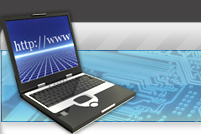Biometric Retina Scanner
Biometric Retina Scanner provides a sophisticated means for identifying people by the pattern of blood vessels on the retina, which is the innermost coat of the back part of the eye. The biometric retina scanner is typically the size of a shoe-box, but the technology in it allows it to map the unique pattern of blood vessels on the retina. This pattern is absolutely unique and so complex, that even identical twins don't have the same configuration. It's estimated that retinography is so precise that it has a an error rate of just one in a million.
Retinography is the future. Ten or twenty years from now, when biometric retina scanners will be used in all possible places, there won't be a need to carry an ID. Instead of using a special card to swipe into rooms, some universities have installed biometric retina scanners so that students can be identified. Brian Cairney, director of business development for Palm Secure at Fujitsu Computers, says the following about such biometric devices: "It's being used the same way as it is in the commercial world. I think biometric identification is becoming more and more useful. Companies are looking at it as a means to protect people. I think it will become more and more frequent as it becomes more user-friendly and more affordable."
The biometric Retina Scanner uses infrared light to map the human eye. When an individual looks into the eyepiece of the biometric retina scanner, an invisible beam of ultra low energy infrared light traces a circular path on the retina at the back of the eye. This part of the eye is filled with capillaries which absorb more of the infrared light than the surrounding tissue. Because it absorbs more light, the reflection is also different and this allows the scanner to map the image, by measuring the reflection at 320 points along the beam path. Depending on the measurement, it assigns an intensity grade between zero and 4,095, compresses the number into an 80-byte computer code that can later be compared to the existing patterns which have already been saved in the database.
There are several major advantages that retina scanners provide compared to other means of identification such as fingerprinting or voice recognition. First of all, they don't require that much computer memory. Second, they are not subject to contamination from dirt or finger misplacement. The third one is that such biometrics devices don't depend on the surroundings, such as background noise or changes in the voice. Retina scanners are more reliable than finger models, because they can be fooled just by using a printed image of the person's finger.
Privacy Policy
| 


